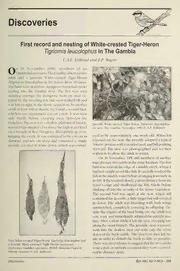
First record and nesting of White-crested Tiger-Heron Tigriornis leocolophus in The Gambia PDF
Preview First record and nesting of White-crested Tiger-Heron Tigriornis leocolophus in The Gambia
First record and nesting of White-crested Tiger-Heron Tigriornis leucolophus in The Gambia C.A.E. Kirtland andE.P. Rogers O n 16 November 1996, members of an OrnitholidaystourtoTheGambiaobservedtwo adult and a juvenile White-crested Tiger-Heron Tirgriornisleucolophus in the Lower River Division. Thebirdswereinnarrow,mangrove-borderedcreeks leading into the Gambia river. The first was seen standing amongst the mangrove roots on mud ex- posed by the receding tidebut soon walkedoffand was lost to sight in the dense vegetation. In another creekatleast400mdistant,we found a secondbird, which to ouramazement was on a nest. It was seen only briefly before creeping away between the bwroavnechnetsw.iTgshesinteusattewdacs2amsahbalolvoewtphleahtifgohr-mwoaftelroolseevleyl Jounvenneislte, TWhhieteG-acmrbeisat,edNToivgeemrb-Heerro1n99T6ig(rCi.oAr.nEi.sKlierutlcaonldo)phus on a branch ofRed Mangrove Rhizophom sp over- hanging the creek. It was estimated to be c40 cm in ered to be approximately one week old. When left diameter and ten cm deep and contained a single exposed on the nest, the juvenile adopted a typical juvenile covered in white down, which was consid- ‘bittern’posturewithextendedneckandbillpointing skyward. The nest was photographed and we then withdrewto allowthe adulttoreturn. On 30 November, EPR and members ofanother touralsosawtwoadultsinthesamelocation.Thefirst birdwasseenontheedgeofamuddycreek,whereit hadjustcaughtaneel-likefish.Itcarefullywashedthe fishinthemuddywaterbeforearrangingitsecurelyin itsbill. Itthenretiredslowlyashortdistancefromthe water’s edge and swallowed the fish whole before slinkingoffintothesecurityofthedensevegetation. The second bird was again at the nest, which still containedthejuvenile, alittlelargerbutstillcovered in down. The adult was brooding with both wings outstretched, completely covering its offspring. De- spite the engine ofthe boatbeing cut, the adultwas verywaiyandimmediatelyadoptedtheuprightpos- ture. Aftera shortwhile it leftthe nest, creepinglow along the stout branch. The juvenile, now exposed, sank into the shallow nest cup with only the white downofthebackvisible. Theobserversthenleftthe Two White-crested Tiger-Heron Tigriornisleucolophus and site in order to disturb the birds as little as possible. a juvenile Black-crowned Night Heron Nycticorax Therewasnoevidencetosuggestthatthetwoadults nycticorax(middle) specimen, British Museum (Natural wereapair,asonbothoccasionstheywereaconsid- History section) (C.A.E. Kirtland) erable distance apart. Discoveries BullABC Vol4No2- 105 . At the time ofthe observation, the only descrip- 25°E,fromSierraLeoneeasttoCameroon,theCentral tion and illustration available to us depicted a bird AfricanRepublic,GabonandtheformerZaire2-3.The withnobuffbarringontheupperpartsandquoteda nearestpartofitsknownrangetoTheGambiaisSierra lengthof76end.Thebirdsobservedwereconspicu- Leone,c640kmtothesouth-west.Thisisnotonlythe ouslybarredbuffandblackandalsoappearedshorter firstbreedingrecordinTheGambiabutalsothefirst than 76 cm, although they were usually seen with documented record, although a previously rejected necksretracted.Anexaminationofspecimens inthe claim from 19824 should perhaps now be re-exam- BritishMuseum(NaturalHistory),Tringshowedcon- ined.TherecordshavebeensubmittedtoTheGambia siderablevariationin thewidthofbuffbarring, from Ornithological Society Records Committee. Such an 3-10mm.Thelengthfrombill-tiptotail-tipalsovaried unobtrusiveandretiringspecies,notoriouslydifficult markedly, more so than could be expected from to observe in its preferred habitat ofdense riverine differences in skin preparation. The largest, a male, forest2-3, couldeasilybeoverlookedanditispossible was81cm;thesmallest,afemale,wasjust56cm.The that small populations exist elsewhere outside its white crest was not noted in the field but in the known range. specimensexamined,thewhitefeatherswerealmost Acknowledgements neentnitr.elOynovenreliatihderbyocdcaarskierononweesraendannyotvaotcaalllispartoimoin-s The staff at the British Museum (Natural History), Tring are acknowledged for allowing access to the heard; bothobservations occurredbetween08.15 hr skincollection. 7 and 11.30 hr. Rather surprisingly, only one other nest of this References species has been described. Brosset1 was shown a 1. Brosset, A. 1971. Premieres observations surla re- nest in Gabon on 22 January 1971, which was also productiondesixoiseauxafricains.Alauda39: 112— situatedonbranchesoverhangingacreek,ataheight 126. ofsix m. This nest contained one egg and the adult 2. Brown, L.H., Urban, E.K. and Newman, K. (eds) proveddifficulttosee, movingawayattheapproach 1982. TheBirdsofAfrica Vol 1. London: Academic- ofobservers,whohadtoconcealthemselvesforlong Press. periods inorderto identifythebird. 3. del Hoyo,J., Elliott, A. and Sargatal,J. (eds) 1992. Althoughlittle iscurrentlyknownaboutthe spe- Hloanna:dbLoyonkxEodfitchieonBsi.rdsofthe World. Vol 1. Barce- cies’ breedingbiology, it is said to coincidewiththe 4. Gore, M.E.J. 1990. The Birds ofThe Gambia: an rainyseasonandtobefromMay-Julyinthewestofits annotated check-list. 2nd edition. BOUCheck-list range and November-January in the east23. This, No.3 London: BritishOrnithologists’ Union. however, conflictswith a laying date ofSeptember- 5. Serle,W„ Morel, G.J. andHartwig,W. 1977.AField OctoberquotedforSierra Leone2-3andourGambian GuidetotheBirdsofWestAfrica. London: Collins. observations. The distribution of this species is in c/o Ornitholidays, 1-3 Victoria Drive, Bognor Regis equatorial rain forest between 80N-5°S and 13°W- SussexP0212PW, UK. , Golden Eagles Aquila chrysaetos in Ethiopia Peter Clement T ie recent reference to Golden Eagle Aquila these records lacking substantative details, and that chrysaetos in Ethiopia {Bull. ABC 2: 61-64) is those in the early years ofthe 20th century may be overdue acknowledgement ofthe species’ presence based on hearsay, they are probably now best re- innorth-eastAfrica,fortherehavebeenreferencesto gardedas unproven. sightings of the species in Ethiopia since the early Records in the late 1980s years ofthe present century. The earliest published reference is Reichenow/ who considered that the Thefirstofa series ofrecentsightings fromthe Bale Mountains,wasoftwoadultsandasubadulton12-13 speciesmightbeawintervisitorbutgavenodetailsor locations. Zedlitz6 reported a sighting at Ela Bered November 1988 (David Mills/Naturetrek). The fol- (nowEritrea)inFebaiary1908.Thenextrecordswere lowingyearthereweretwosightings-threeindividuals 80 years later, in 1988, when it was included in a toaninssevNeartailondaaltePsarinkN(oDavveimdbMeirll1s9/N8a9tuinretthreekB)a,leanMdouonn-e checklistofEthiopianbirdsbyF. Petretti1. Inviewof 106-BullABC Vol4No2 Discoveries
